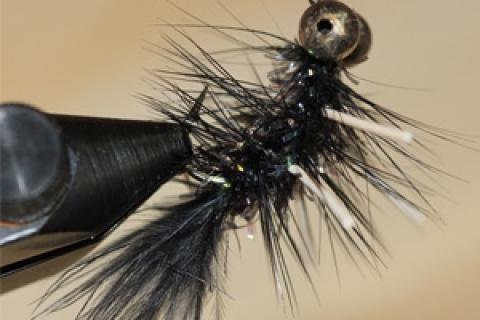
 With so many different carp/sucker flies on the market, how does an individual find their way through the endless flash and feathers to the perfect fly?
With so many different carp/sucker flies on the market, how does an individual find their way through the endless flash and feathers to the perfect fly?
First and foremost let's get the idea out there that most flies are tied to catch the fly tiers eye rather than the fish. These fish by nature are elusive and can be very difficult to interest, but most of all favor simplicity. These underappreciated fish have diets that are very basic. They can eat a vegetarian diet of water plants but prefer to scavenge the bottom for insects, crustaceans, crayfish and worms. Having a fly pattern that resembles multiple items from their respected diet will better your chances of hooking up with fish.
Barr's Spork is just such a pattern. Tied to initially imitate a crayfish, it can also pass as a large aquatic insect or worm. This fly has all the qualities you would expect in a carp and sucker producing pattern: sultry movement, soft materials, sturdy hook and a weighted head. Because of the fish's general shy nature, the weight of the fly becomes very critical to an anglers success. Flies that are able get to the bottom without creating a huge entry splash is key since they can be casted closer to foraging fish without spooking them. Predicting feeding behavior is very difficult so getting the fly as close to the fish as possible increases your odds of a fish taking interest in what you have to offer.
To fish this fly, cast out in front of a forging fish and let your fly sink to the bottom. With slow, small strips, jump the fly along the bottom while keeping an eye on the movements of the fish. Don't expect carp/suckers to race over and inhale your fly. These fish will have a slow cautious approach while feeding and in many cases you will have a very hard time actually feeling or seeing the bite.
If you think that a fish has picked up your fly, lift the rod slightly and feel if there is any weight on the line. If nothing is there let the fly be. Stripping the fly when the fish is this close will only spook it. Now if you check the line and there is weight, don't set the hook wildly. Simply lift the rod and give one small jerk to place the hook and hold on, you are going to be in for a great fight.
Barr's Spork Materials List
| Hook | Curved Hook Shank, Size 8 |
| Thread |
Black Uni Thread 8/0 |
| Eyes | Large, Silver Bead Chain Eyes |
| Tail | Black Marabou Hair |
| Body | Black Crystal Flash Chenille |
| Hackle | Black Saddle Hackle |
| Legs | White Round Rubber Legs |
| Rib | Black 6/0 Thread |
Step-By-Step Tying Instructions
|
Step 1 To start this fly place the hook into the vice jaws and secure it in place tightly. |
 |
|
Step 2 Attach the thread to the hook shank at the front of the hook and with figure eight thread wraps secure the bead chain eyes on top of the hook shank just behind the hook eye. |
 |
|
Step 3 Cut a small bunch of black marabou and tie it down to the top of the hook shank so that it extends of the back of the hook shank about 2X the width of the hook gape. |
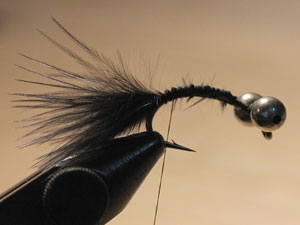 |
|
Step 4 Tie in a black saddle hackle tip first and wrap it down with thread extending off the back of the hook shank. Stop at the point above the barb. Advance the thread back to the front of the hook. |
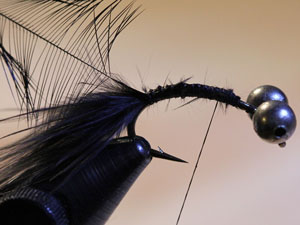 |
|
Step 5 Tie in a three inch section of Black Crystal Chenille and wrap it down with thread extending off the back of the hook shank. Stop at the point above the barb. Advance the thread back to the front of the hook. |
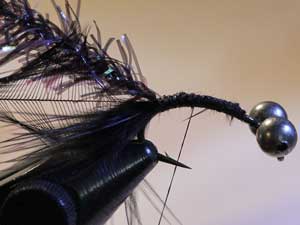 |
|
Step 6 Tie in a four inch section of black thread and wrap it down with thread extending off the back of the hook shank. Stop at the point above the barb. Advance the thread back to the front of the hook. |
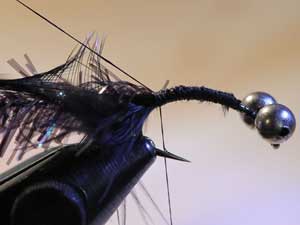 |
|
Step 7 Cut 2 separate two inch strips of white rubber legs and tie them down to the hook shank with figure eight thread wraps at the 1/2 and 3/4 marks on the hook shank. |
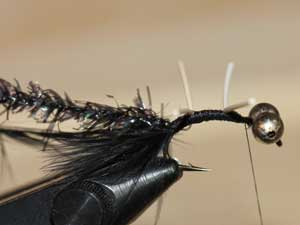 |
|
Step 8 Wrap the Chenille towards the front of the hook and make sure to sweep the fibers towards the rear of the hook as you work your way up the body of the fly. Watch out for the rubber legs so that you do not wrap down any of the legs. Stop just behind the bead chain eyes. |
 |
|
Step 9 Palmer the black hackle forward up the body of the fly in the opposite direction that you wrapped the chenille. This allows the hackle to sit on the chenille rather than fall into the seams created by the wrapped chenille. Take one or two turns of hackle in-front of the bead chain eyes and tie the feather off. |
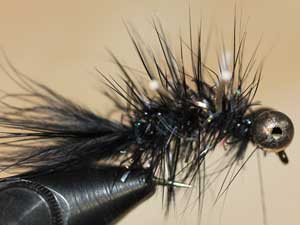 |
|
Step 10 Wrap the black thread carefully up the body of the fly in the same direction that you wrapped the chenille to secure down the hackle. Take care in doing this step so that you do not wrap down any of the hackle fibers with the thread. Build a small head with the thread in-front of the bead chain eyes and whip finish then cement the head. |
 |
- 4252 views

